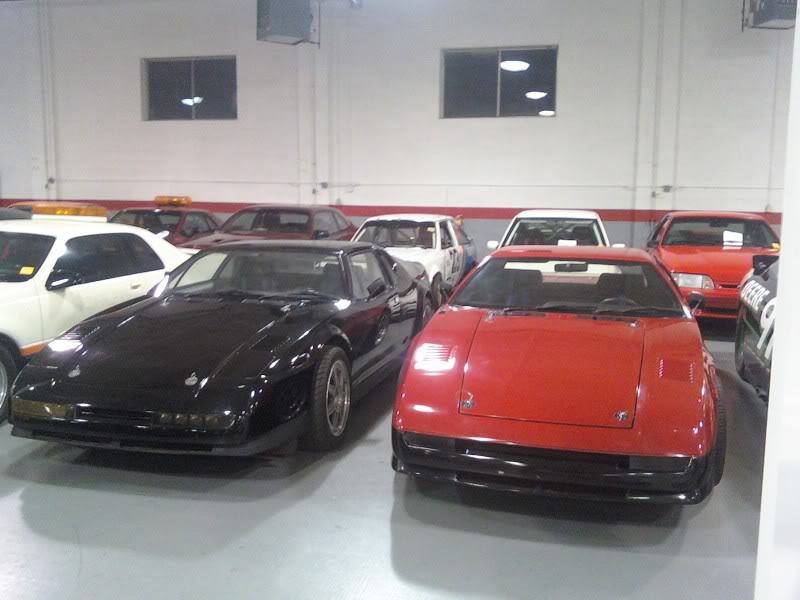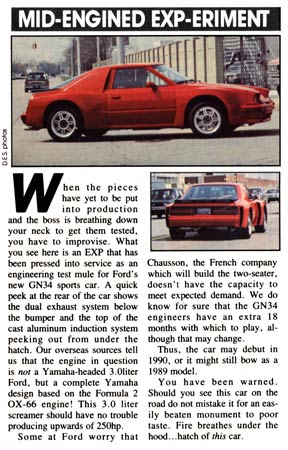It was first seen as a wild-ass one-off test mule…at one point in time been a first-gen Ford EXP that had gotten the IMSA bodykit treatment. There were box fender flares all around, the quarter window had been covered over, dual pipes were sticking out of the back and under the rear hatch sat a 3.0L Yamaha V6, just like the one that would appear in the Ford Taurus SHO. To say that there was collective surprise and shock at Ford developing what appeared to be a Fiero-fighter was an understatement. While information was slim at the moment, there were rumors that the engine size was being punched up…maybe it was a 3.2, maybe a 3.4, or was that 3.6L? Other rumors claimed that the EXP mule was packing all-wheel drive with a central differential. What the hell was Ford up to in the mid-1980s?
SVO was high off of the success of the SVO Mustang, the punchy turbo-four Fox body that would surprise the hell out of quite a few people, and they wanted more. Unfortunately, SVO was not having luck in getting their next vehicle lined up, especially since it’s about this time period that the Mustang came closest to being killed off. So they decided that they would try to build up their own vehicle. Designs were sought out, and the winner came from Ghia. No photos of this car exist, though several people recollect seeing it around Ford buildings during testing. Reportedly it was black and resembled a Ferrari Testarossa, and had an engine note that didn’t sound like the Yamaha motors, yet didn’t sound like a V8, either. According to someone who claims to have been involved with the project, numerous engines were tested, including punched-up V6s and V8s. The team did not want to use the 5.0L V8 because they felt it was too “low-tech” to be powering the new car, but the upcoming 4.6L V8 wouldn’t be ready in time, so a 351 was used in one of the Pantera-sourced cars to simulate weight and power.
Now, with that being said, there are conflicting reports as to the real purpose of the cars. One claim is that the cars were simply built to test the effects of weight distribution. Some claim that the SHO engines were destined for the GN34 while others say that the Taurus deal was already done. Either way, the engineers at Ford were having a ball with the cars, as they were ran on the track often and hard, with one individual saying that he had pictures of Jackie Stewart beating the holy hell out of one at a track (unfortunately, any pictures that were posted were gone, along with the website that was linked.)
Out of all of the known mules, there are two actual GN34 vehicles in existence, and both are in Jack Roush’s collection. The red one is an all-wheel-drive version with a Yamaha V6 of some type, and the black car is the 351-powered test mules, both cars using ZF 5-speed manuals. The surviving GN34s are both based off of a 1985 Pantera GTS (if you look carefully around the windshield and door glass, it should appear) with custom tube chassis sections and body shells.
So why did the GN34 program stall out? It came down to money: Ford only had the budget for one vehicle platform to go ahead to production, and it was a coin toss between the GN34 and one that was simply known as “four door Bronco”, better known to us as the Ford Explorer. That’s the truth of it, folks: Ford shut down a mid-engined sports car for what became the ultimate symbol of the urbanite SUV. Financially, it was a smart decision as we all know, but the “what could have been” factor for the GN34 is pretty high.




























OK, this is one I’ve never even caught a whiff of before. How in the hell did you find this?!
I was scrolling through Ford EXP searches when I saw the AutoWeek article. AWD EXP with an IMSA body? Had to check.
Keep doing whatever it is you’re doing Bryan, I love this stuff.
That’s no “Fiero fighter”, it would mop the floor with the Fiero… great car and story. The red chassis definitely has the SHO-style intake manifold. Sweet motor, had an ’89 SHO not long ago that was just a blast. It would spin tires through first and second gear and sounded amazing doing it; the speedometer would just lay over like it was connected directly to the skinny pedal.
I wouldn’t be so quick to blame the Explorer for the GN34’s demise. Can’t see the GN34 being a high volume seller. Also consider that the Explorer didn’t require that much development money; the Bronco II and Ranger already had the new interior/exterior styling as of 1989, two years before the first Explorer, and the chassis and suspension were mainly carryovers with upgrades. About the only unique parts of the Explorer were the grill, interior and exterior from behind the front seats backward, and new wheel designs. It took the highest-spec Ranger parts and for little development cost made a ridiculously durable SUV.
We should all be glad the 4.6 didn’t end up in the GN34. Bad enough we are still saddled with the Modular design, which took almost 15 years of development to make any real power. I really wish Ford had stuck with the Windsor longer and made a new generation OHV engine to replace it.
Yeah, as much as I love the Fiero, a mid-engine car with the Yamaha V6 would have been an absolute rocket ship (Although, the ’89 Fiero prototypes had 3400 Twin-Cams, which would have made it a bit more of an even fight)
I asked a friend that works for Henry in Dearborn and he said it was the Exploder that killed it as well. Getting more info here and there from him since seeing this article and I REALLY want this car to exist now. Great move for the bottom line, depressing move for the Petrol Heads.
I’m not sure the Exploder is the ultimate symbol of suburban domestication, I’m pretty sure any one of GM’s wallowing behemoth SUVs pretty much fit the bill: big, boxy, stupid, and so grossly top-heavy and saddled with such poorly-made front-end tackle that anything rougher than a molehill would make the 4WD kerplode.
I’d be inclined to agree with you; I think the SUVs based on fullsize truck chassis are just too much. The Explorer from 91-02 was based on a Ranger-based light truck chassis, and never has been built on fullsize running gear. The Expedition, Excursion, Tahoe/Suburban and Durango are rarely used to their full designed capacity, and off-road their size and weight (and body cladding) work against them. In contrast the first and second generation Explorer were just as capable off road as the Jeep Cherokee.
I’m with you there, and I think one of the eds here on BS nailed it on a recent station wagon post: the big full-sized SUVs have taken over the station wagon’s niche, but offer less. A wagon built with today’s tech would handle well, get good MPGs, ride comfortably, and fit just about anywhere. These full-sized SUVs offer none of those abilities at a higher overall cost to design, manufacture, purchase, operate, and insure, while at the same time offering a massive safety penalty and increased maintenance costs.
The first-gen Exploders (and Bronco IIs) were great offroad rigs, especially the ones with the tried-and-true Vulcan 6. For Rubicon, I’d take a Wrangler or a Tacoma any day, but for backcountry exploring, camping and getting places, a first-gen Exploder is just about perfect.
Did you mean Cologne V6?
Was it Cologne?
I always thought it was the Vulcan six, the 3.0 liter model.
The Essex six was a good one, too.
The SHO series of engines are their own, a Yamaha-based design, though they share the bell housing pattern with the Vulcan and the Essex due to ease of fitment.
Blue collar Ferrari Dino. Mid engine V6, lightweight.